If you have been researching the best ceiling fans for camper vans, you’ve definitely come across the Maxxair fan. The Maxxfan is debatably the most popular (and most expensive) ceiling fan on the market. You’re skeptical because you want to cut van life costs, but curious to know if it’s worth it…
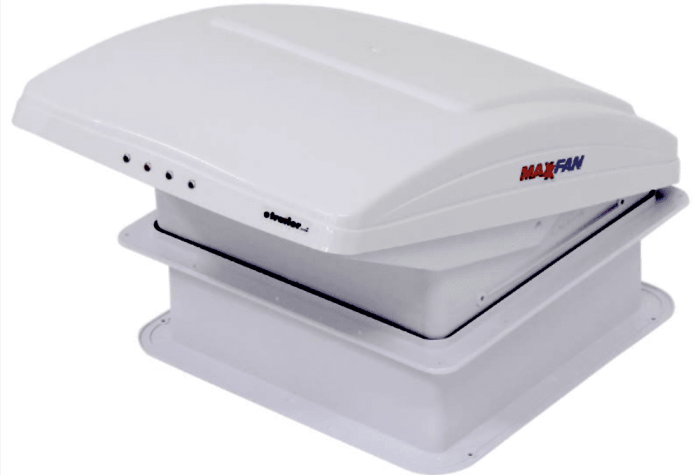
I’m here to say, it’s worth it. Even though this is a budget van life blog, the Maxxair fan deserves a review because it has been a staple of my van life experience. My motto is, “cut costs where you can, and splurge on the worthy items”–the Maxxair is a splurge-worthy item.
Overall Thoughts on the Maxxair Fan
After nearly two years of using the basic Maxxfan model in my camper van nearly every day, here are my thoughts.
Performance: The Maxxfan has ten different fan speeds to choose from, which comes in handy all of the time. Maybe I want a light breeze and white noise to help me fall asleep on a cool evening, or maybe I need a strong fan vent to suck out stinky, smoky air from the van while cooking. The fan’s intake and exhaust modes are incredibly handy for anything from “vacuuming” out gnats or cooking smells, or bringing in fresh air.
Control Panel: I find the control panel really easy to use. All of 5 the control buttons are located in one corner of the fan’s frame, and the lid knob is located in another corner. The buttons lay flat and straightforward to understand, thanks to their little icons and text. The buttons include one that changes the fan’s intake/exhaust modes (labeled “in/out”), two buttons that control fan speed (plus or minus) one that auto-sets the temperature, and the on/off power button.
Rain Lid: The angled rain lid sets the Maxxfan apart from many other basic van fans on the market. My van gets so clammy and humid-feeling on rainy days, which is a double-whammy since I need to work inside the van if it’s raining out. The fan is a lifesaver by helping circulate some of the heavy, wet air, without letting rain fall in.
Power Draw: I can easily go 5-7 days running the fan all night without having to recharge my batteries (i.e. if my van has been parked in the same spot for 5-7 days.). For reference, I power my van with two deep-cycle batteries that charge off of the van’s alternator when it’s running. So, that’s a huge win for me. The fan pulls maybe 1-3A when set to the mid-to-high fan speeds.
What is the Maxxair Fan?
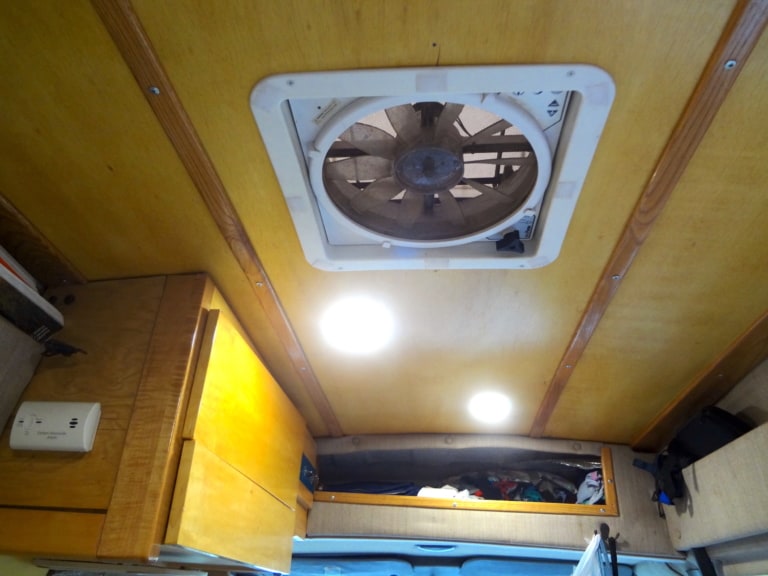
The Maxxair fan is a rain-proof, 10-speed ceiling fan designed for RVs and campervans. It can push air out (exhaust) or suck air in (intake), depending on the mode you set it to.
Maxxair Fan Specs
- Dimensions: 14”x14”
- 10 speed levels
- 12V fan motor
- 10 fan blades
- 900 CFM power
- Rain cover
- Optional remote control (in the deluxe version)
- Fuse protected sealed ball bearing
- Easy to remove insect screen
- Pulls between 6W – 34W (from lowest to highest speed)
Maxxair Fan Features
- Use while driving or when it’s raining
- Use with lid opened or closed
- Set room temperature
- Use intake or exhaust fan mode
- Choose between ten speeds
- Optional programmable remote control
What Does the Maxxair Come With?
- Ceiling fan
- Flange
- Interior fan ring
- Two sets of screws
- Remote (if you bought the deluxe version)
How to Install Maxxair Fan
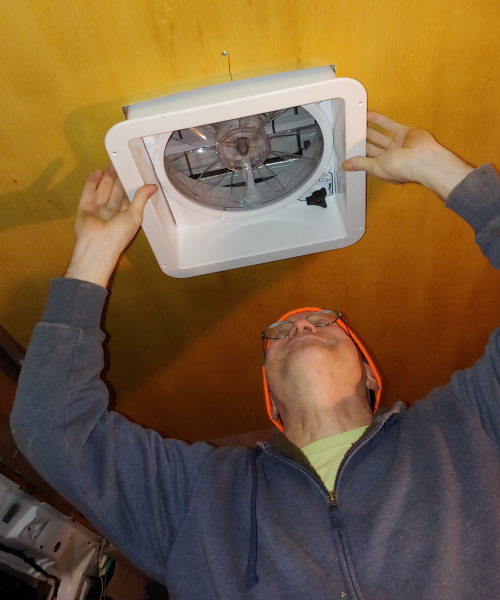
I’ve summarized the steps I took in conjunction with this YouTube video for step-by-step instructions on installing a Maxxair fan. High-level instructions:
- Mark 14”x14” area of where you want to install the fan on your roof
- Use power drill to drill holes into each corner and make sure distance is correct
- Use jigsaw to cut out 14”x14” section, going from one corner to the next
- Use a metal file to soften the edges around the roof cutout
- Use acetone to wipe down the exterior roof cutout area
- Use metal primer (like Rustoleum) to coat the edges of the cutout, let dry
- Secure butyl tape around the flange and insert flange to ceiling hole
- Install your Maxxair fan
- Insert interior fan ring (you’ll probably have to cut this to the depth of your fan area)
- Use self-leveling lap sealant on exterior flange on roof to waterproof and rust-proof
- For wiring, scroll to the bottom section of this article for how to wire the Maxxfan
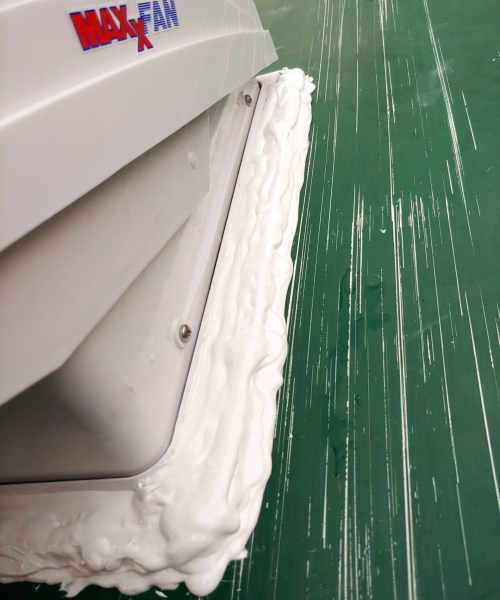
Practicality of the Maxxair Fan
I find the controls on the Maxxair fan very simple and intuitive to use. Simply turn the knob to open the fan lid, press the “in/out” button to put it in exhaust or intake mode, and press the plus or minus buttons to set the speed. My fan has a temperature set feature but I’ve never used it–so I can’t speak to that, but it doesn’t seem like a needed feature.
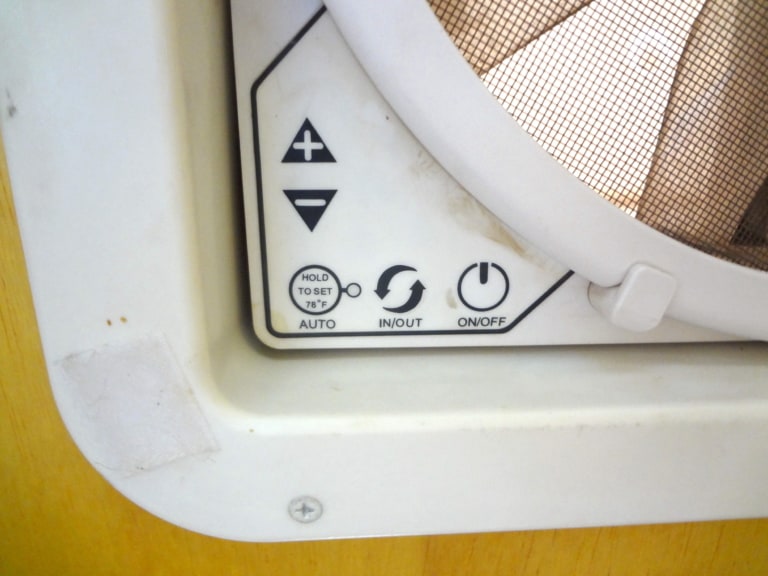
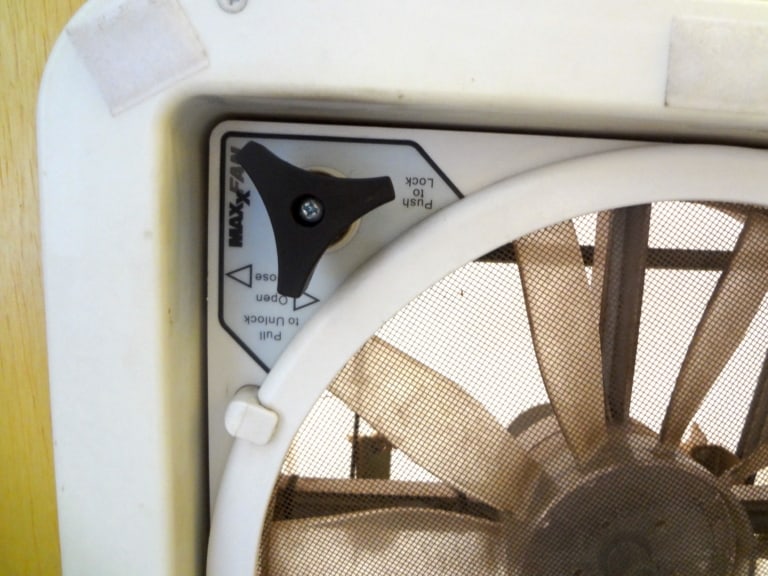
My Maxxair fan is located in the center of my van’s ceiling, so I can reach it from my bed or my “kitchen” area. I opted for the original version (without the remote for automatic control) because I figured I could reach the fan’s controls manually from anywhere in my van. Over the last couple of years, this setup has worked just fine for me. I think the remote would end up just getting lost like everything else in my van seems to do!
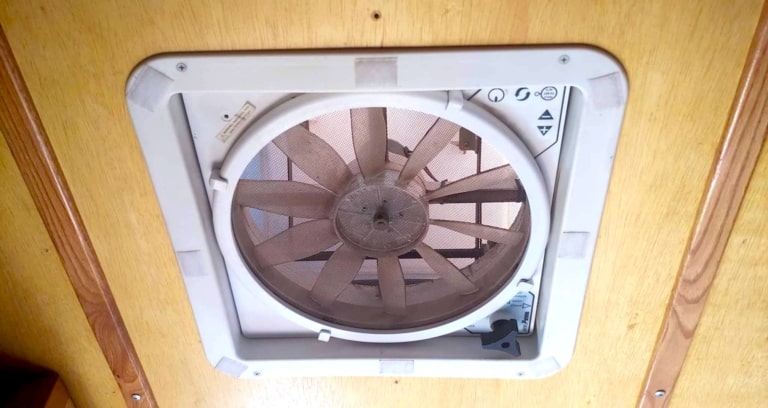
You may notice the velcro squares placed around the rim of the Maxxfan. I added those so I could velcro a sheet of reflectix over the fan on cold nights. But, I rarely end up using it and not convinced it makes a noticeable difference anyways. The Maxxfan lid seals well.
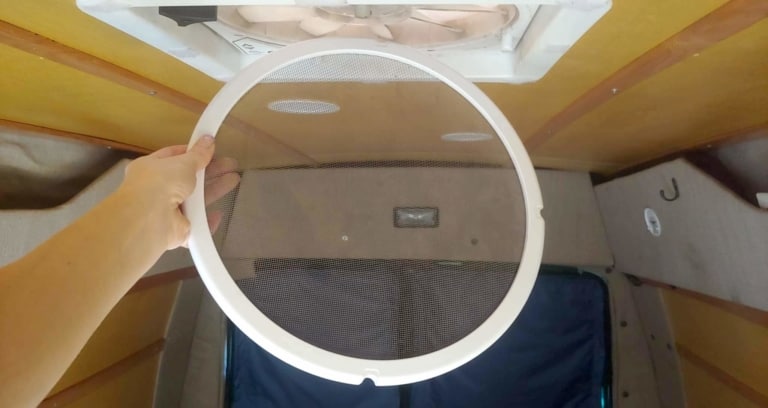
The mesh screen is easily removable. Every few months I give the screen a good wash with soap and water (very satisfying to watch all the dust come off) and wipe down the fan blades. Makes it look like new!
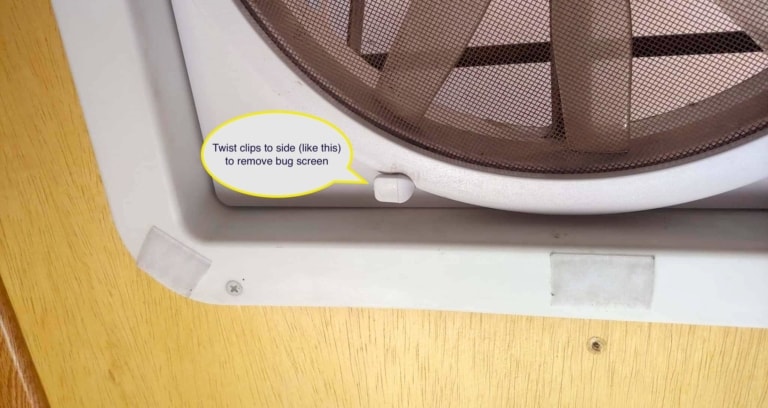
If you want to remove the insect screen to clean the Maxxfan or the screen, just twist the four plastic clips placed evenly across the screen.
Performance of the Maxxair Fan
I use the Maxxfan on a daily basis. Whether it’s to cool off the van during the day, vent the van from weird cooking smells, or as white noise while I sleep. If it’s cold out, I still keep the fan on but just keep the lid closed. The fan is so quiet in fact, I have to turn it to at least midway speed for it to make enough white noise. I have recorded podcast episodes from the van with the fan on – that’s how quiet the fan is! This is great when I’m stealth camping in hotel parking lots too, because I don’t worry about someone hearing it.
On really hot days, I wish the fan could put out a stronger breeze–this is when I wish I had two fans to maximize air circulation. My van has very minimal insulation and heats up very easily. If I keep the van doors open with the fan going, it definitely increases the fan’s effectiveness. Don’t get me wrong, the fan puts out a mean breeze and even the biggest fan probably can’t cool my van’s interior (since it isn’t an AC).
The fan’s rain lid does a perfect job at keeping rain out, whether it’s open or closed. This is nice on those humid, rainy days when you want to keep circulating the air because the van’s air feels heavy and clammy with moisture.
The fan also uses minimal power from my deep-cycle batteries. I can run the fan for a straight 24 hours and still be okay on power levels. That being said, the wiring in my fan must have come a little messed up. If my power gets too low, the fan goes into overdrive at max speed and won’t shut off, rather than shutting off automatically. That is definitely a malfunction and I don’t know if it’s just my fan or the “norm”.
Price of the Maxxair Fan
As of August 2023, the basic Maxxair fan model costs $256 on Amazon and the deluxe Maxxair fan with remote control costs $321 on Amazon. Compared to the rest of the fans on the market, that’s a reasonable price for what you get (in my opinion). Most fans are in the same price range as the Maxxair, but their designs are simpler with less functionality.
For example, Dometic’s Fan-tastic fan is a popular campervan fan. Yet it only has three fan speeds, no rain cover, and is significantly louder (I know because I listened to my friend’s fan who has one in his van). So in my opinion, it’s a no-brainer to go with the Maxxair fan.
Don’t underestimate the power of your campervan fan! It’s so critical to your comfort level and yet it’s often overlooked in the van build process!
Maxxair Fan FAQs
Is the MaxxFan worth it?
The Maxxfan is 100% worth it, in my opinion. It’s packed with features that make it more than just a basic van fan: both intake/exhaust mode, ten different fan speeds, a rain lid so you can still use in inclement weather, very low power consumption so you can have peace of mind you won’t drain your power supply…it checks all the boxes for me.
Can you ues the Maxxair fan while driving?
Yes, you can use the Maxxair fan while driving and even have the rain lid lifted up while driving. According to Maxxair, “the MAXXFAN and MAXXFAN Plus are designed with dual lifting arms to fully support the lid if installed properly.” I’ve used the fan while driving and never had issues.
How much power does a Maxxair fan use?
The basic Maxxair fan model will draw between 1/2Amp – 5Amps, depending on the fan speed. The faster the fan speed, the more power it will draw.
Why You Should Invest in a Van Fan
Control Temperature: Even the best van insulation can’t keep out heat on a hot summer day, no matter how hard you try to cool your van. A ceiling van fan does wonders for cooling down the inside of your van. Many vanlifers even install two ceiling fans to maximize air circulation.
Reduce Condensation: Cooking, showering, or doing dishes in your van creates humidity, which creates condensation in your van. Condensation slowly eats away at your van’s interior–creating rust, mold, weakening of wood or glues. Over time, it can become hazardous. An RV fan helps circulate the moisture outside of your rig.
Vent Harmful Fumes: Propane-powered items such as camp stoves or portable heaters can emit low levels of carbon monoxide. When you’re in a small, confined space like a campervan, you need a way to vent this out and a ceiling fan is the perfect way.
Sleep Peacefully: There will be nights in your campervan where you have to sleep at a truck rest stop, or in a crowded camping area, or close to the highway. A fan helps drown out the surrounding noise and get you a better night’s sleep.
Suck Out Bugs: Bugs (especially those little desert flies) always find their way into your van. With fans such as the Maxxair, you can manually remove the fan’s insect screen, put the fan on “exhaust” mode, and literally corral the little bugs until they’re sucked out of the van!
Save this on Pinterest


